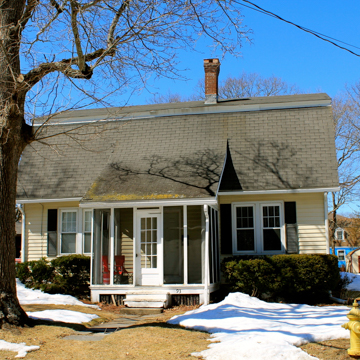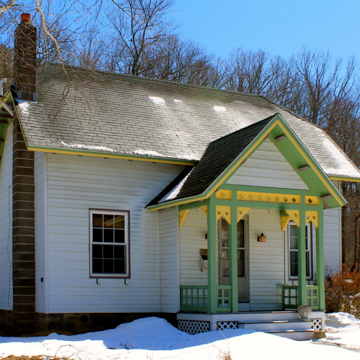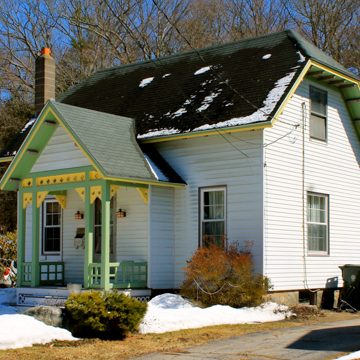You are here
Oakgrove
Constructed as company housing for the Willimantic Linen Company, the Oakgrove neighborhood stands as a physical manifestation of progressive business practices and workers’ rights in the late nineteenth century. Envisioned by company president William Eliot Barrows (1842–1901), Oakgrove originally featured a school as well as Barrows’s own estate. The neighborhood of forty single-family dwellings is an early example of workers’ housing in the United States and is notable for its suburban form and the progressive leadership of Barrows in his offering of services and amenities to residents.
The Willimantic Linen Company developed a workers’ housing initiative in 1865, with the purpose of providing affordable housing to its workers, close to the main mill buildings in Willimantic, Connecticut. The mill produced linen from 1854 to 1872, at which point the company switched over to cotton. With a capacity to manufacture 4,000 pounds of cotton per day, Willimantic Linen Company was the leading thread-making company in the United States, built along the Willimantic River for accessible shipping. It was not until the late 1870s, when Barrows took over as president, that the company produced concrete plans for workers’ housing. Simultaneously, Barrows began the construction of Mill No. 4, the largest cotton mill in the world at the time, which brought national attention to the company. Previously in the 1860s through the 1870s, workers lived on housing tracts in worker villages called Iverton and Carey Hill, both adjacent to the mills along Main Street. The company required additional housing due to the cramped living conditions and the increased number of workers after the completion of Mill No. 4. The housing project provided workers with plenty of comfortable living space, a sharp contrast to typical housing conditions in the industrial age. Most of the houses were built between 1880 and 1881, and the neighborhood was named Oakgrove (also known as “the Oaks” by the new residents). Located less than half a mile away from the mills, Oakgrove mainly runs along Quercus Avenue, named by Barrows after the Latin word for oak tree.
There are four different house designs spread out evenly through the neighborhood, with a selection of hipped, cross-gabled, gambrel, and saltbox roofs. Indeed, the “great variety of styles” was recognized by the census examiners from the U.S. Department of Labor in 1883, and thus gained national attention for the entire company. The average property size was 10,500 square feet, with the house only taking up about one tenth of that land—a welcome change from the close quarters of previous housing, where workers and their families lived on narrow divisions of land on the busiest road in town. This provided enough outdoor space for clotheslines, lawns, walkways, and gardens. For a time, the company offered residents lessons on garden cultivation and prizes for the best flower gardens. All houses were fitted with electric lighting and featured six rooms, including a kitchen, parlor, sitting room, and three bedrooms, with the layout varied in arrangement and room size between house designs. The relatively plain exteriors offer bits of molding and window trimming that further differentiate each house. The simple Victorian detailing was influenced by Andrew Jackson Downing’s publications on residential cottage design.
These houses marked a watershed in workers’ living conditions in America. Although there were some similarities between Oakgrove and the contemporaneous Town of Pullman, the rent for single-family residences in Willimantic was only $1.92 per week, compared to $15 to $50 per month for a home in Pullman. When there were wage cuts in the 1880s due to a deficit in the economy, Pullman maintained the same rent prices, while Willimantic reduced rent to accommodate workers. Also in the neighborhood were a library and a school for the workers’ children. These facilities hosted social events for the employees, which Barrows made mandatory for workers to attend. Barrows spent an immense sum of the company’s profits to accommodate his social experiments, one of which was to offer employees scheduled breaks. Though some enjoyed this treatment, many employees found Barrows’ paternalistic behavior to be intrusive. Barrows left the company in 1883 to work at Pullman Palace Car Company, but quit a year later when he saw the despotic and impersonal nature of the company in comparison to Willimantic Linen.
In 1898, the American Thread Company bought out Willimantic Linen Company, but workers continued to work at the mill, just under new management. As the company grew, new housing in the form of tenements and apartments were built around the city, although the Oaks remained the most desirable neighborhood. Due to wage cuts, workers staged a major strike in 1925, and hundreds were evicted from company housing. By 1985, the mill finally closed its doors, and the Oaks cottages were either bought by residents or sold. Today, all forty houses remain on their original lots, although they have since been painted a variety of colors and some now have small additions and garages. Since 2012, the school at 47 Crescent Street has served as a senior center.
References
Beardsley, Thomas. “At last, Willimantic gets a public park.” The Chronicle (Willimantic, CT), February 2004.
Beardsley, Thomas. “William Barrows and his vision for Linen Co. workers.” The Chronicle (Willimantic, CT), January 2004.
Beardsley, Thomas. “William Barrows’ pride and joy.” The Chronicle (Willimantic, CT), January 2004.
Beardsley, Thomas. “William Eliot Barrows.” Windham Textile and History Museum. Accessed June 7, 2021. https://millmuseum.org/.
Beardsley, Thomas. Willimantic Industry and Community: The Rise and Decline of a Connecticut Textile City. Windham, CT: Windham Textile and History Museum, 1993.
Crawford, Margaret. Building the Workingman’s Paradise: The Design of American Company Towns. New York: Verso, 1995.
Ralston Lovell Gould, Elgin. “Willimantic Linen Company, Willimantic, Connecticut.” In The Housing of the Working People: Eighth Special Report of the Commissioner of Labor, 327-328. Washington: Government Printing Office, 1895.
Writing Credits
If SAH Archipedia has been useful to you, please consider supporting it.
SAH Archipedia tells the story of the United States through its buildings, landscapes, and cities. This freely available resource empowers the public with authoritative knowledge that deepens their understanding and appreciation of the built environment. But the Society of Architectural Historians, which created SAH Archipedia with University of Virginia Press, needs your support to maintain the high-caliber research, writing, photography, cartography, editing, design, and programming that make SAH Archipedia a trusted online resource available to all who value the history of place, heritage tourism, and learning.



































